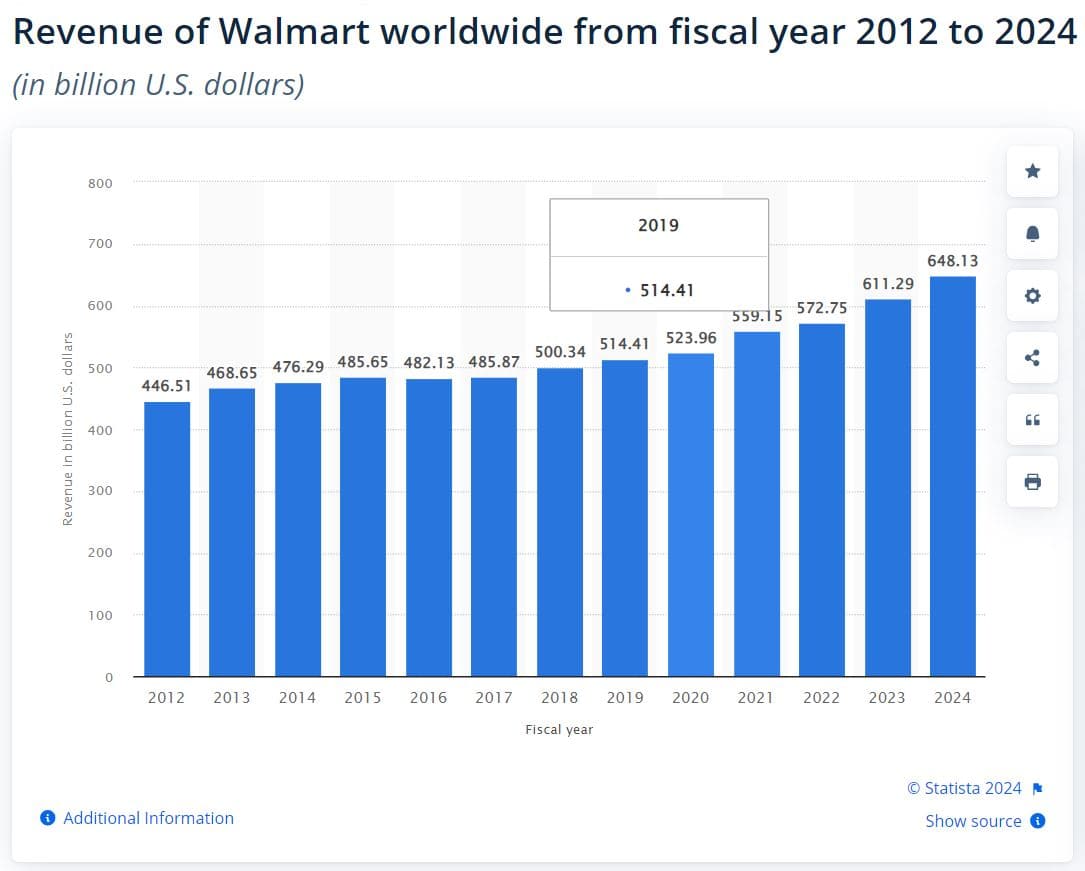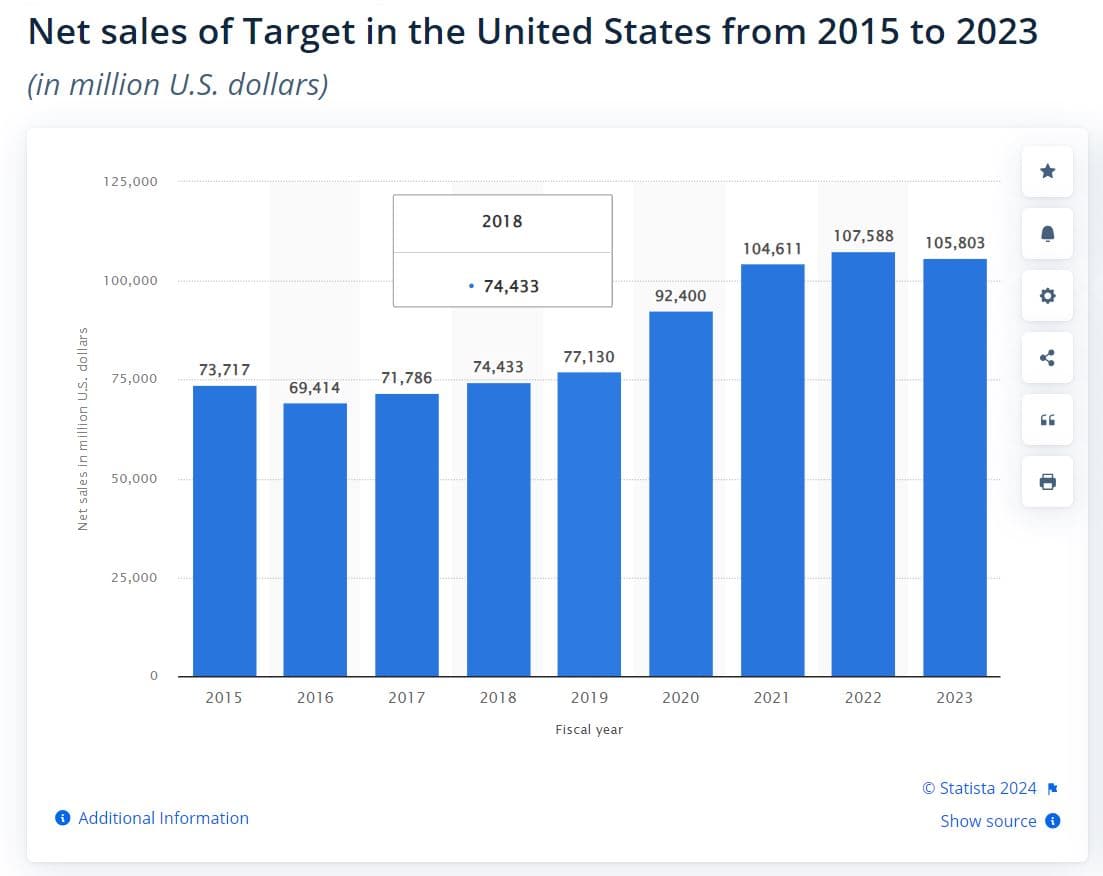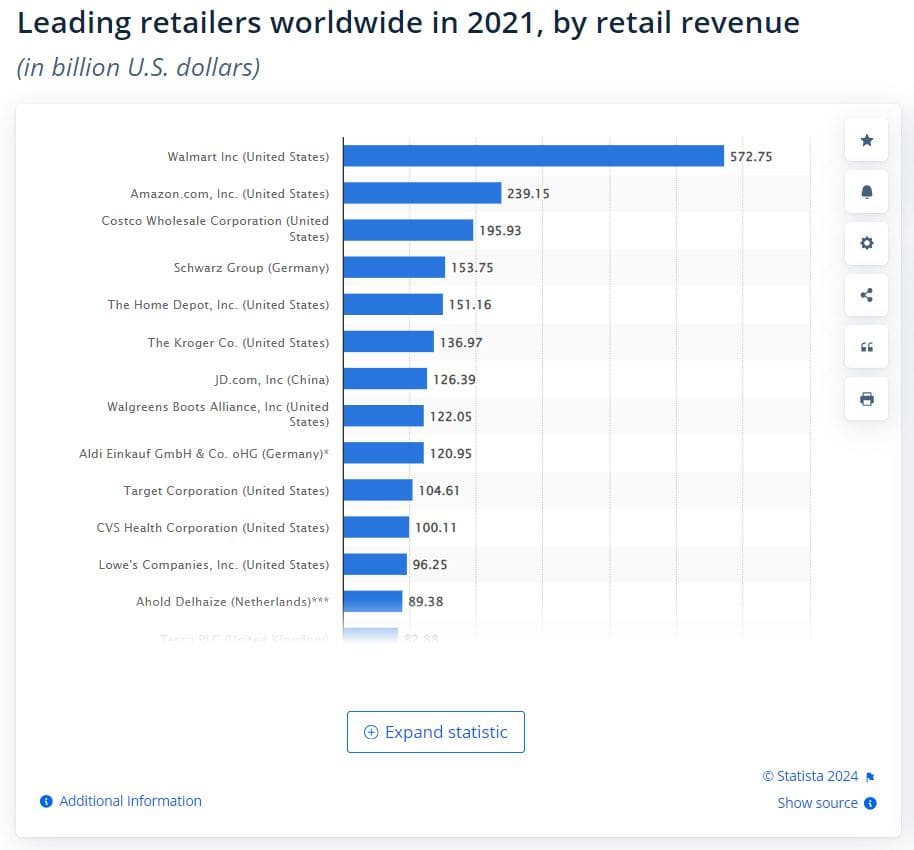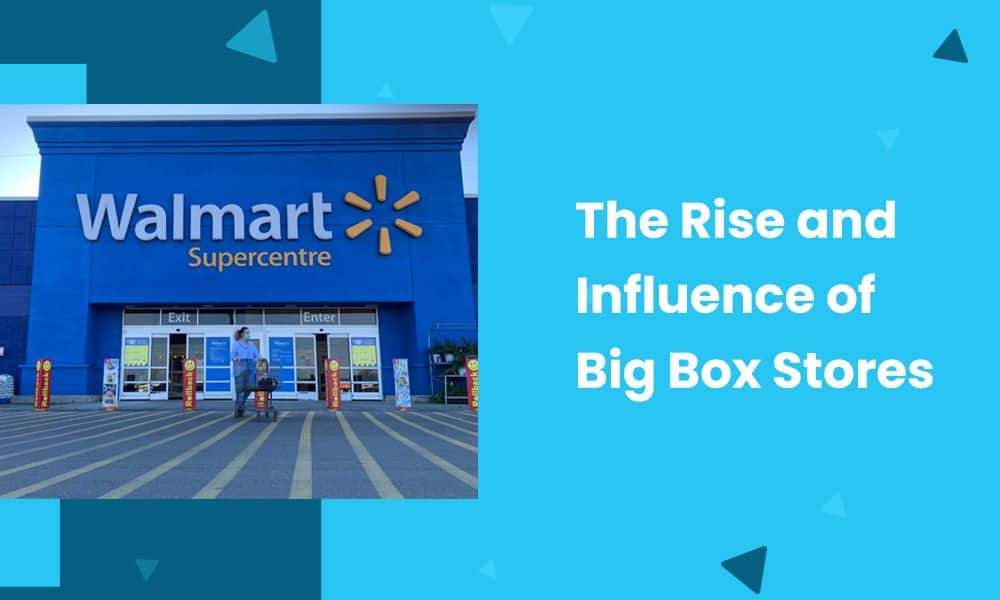Walmart is a classic example of a big box store. You’ll walk past endless aisles offering everything from groceries to electronics, and that too at a great price.
Walmart didn’t come into the picture until 1988. Most people in the US consider Meijer the first to implement the superstores when it opened in 1962 in Grand Rapids, Michigan. Since then, big box stores quickly grew, changing the retail landscape in the country and around the world.
Now, consumers choose consolidated shopping trips for bulk purchases rather than frequent visits to smaller stores. This shift has resulted in the “Walmart effect” — a snowballed impact on local economies, communities, and ecology dynamics.
What’s with this drastic development of big box stores? Is there a way small, local businesses can combat them? Read on to find out.
Table of Contents
What is a Big Box Store?
A big box store or superstore is a retail establishment with enormous physical space and offers a wide range of products from diverse categories. By selling products in large sales volumes at a low-profit margin, they stay on top of the market with very competitive pricing.
What is considered a big-box store?
The term “big box” comes from the way these superstores look. Big box stores often have a simple design and are located in spaces over 50,000 square feet.
They seem like large rectangular “boxes.”
Examples of Popular Big-Box Stores
Big box stores are everywhere, and you probably visit them regularly to get your staples at a low cost. Business models behind a big box store aim to provide consumers with variety and a one-stop shopping experience. They cater to budget-conscious shoppers by providing them with various products at cheap prices.
Some big-box stores are general merchandise stores that offer everything, from food to clothing to electronics; clients can often find it all. Some are specialty stores, which, unlike general merchandise retailers, focus more on certain categories of offerings. Let’s look at some well-known big-box retailer examples.
Walmart
Walmart is a well-known example of some of the biggest superstores. It expanded from its modest past to become the biggest retailer in the world. In 1962, Sam Walton and his sibling James “Bud” Walton established the Wal-Mart Discount City in Rogers, Arkansas.
Since that humble past, the company has changed its name from Wal Mart Discount City to Wal Mart Stores, Inc. Today, it operates in 24 countries with 10,623 discount shops, big-box stores, local stores, and wholesale membership clubs.
The success of Walmart comes from its dedication to cheap pricing and extensive product range as a general merchandise store. With its “Every Day Low Price” pricing approach, Walmart provides consumers with low-cost items and services as a convenient discount store. It is amongst the most famous and valuable big-box brands, with a revenue of 648 billion USD.

Target
Target is another big box store for general merchandise, selling diverse goods, including food, clothing, home décor, office supplies, and gadgets. Its net sales in 2023 were 106 billion USD, which declined by 1.7% for the first time since 2016.
Despite the sales dip, 2023 was an excellent year for the department store, with revenues crossing past all prior benchmarks (except 2022) and up by over $30 billion from the preceding five years.

Even though sales were down that year, the number of stores nationally actually went up by eight. Out of the approximately 2,000 Target’s general merchandise stores in the country, most are in California, about double the number of stores in Texas, which is next in line with most stores.
IKEA
The Swedish furniture and home goods business IKEA was established in 1943 in Älmhult. The company is a well-known worldwide leader in the ready-to-assemble (RTA) furniture industry.
Much of IKEA’s home furnishings are sold in a flat-pack format, requiring the customer to assemble it themselves. However, the company is known for its Scandinavian flair, and its main competitive advantage is its firm grasp of what motivates people to purchase furniture. It uses that knowledge to formulate the IKEA Marketing Strategy, which promotes diverse products for a stylish lifestyle at a low price.
With worldwide sales of approximately 48 billion euros, IKEA has grown swiftly since its inception and is now the biggest furniture manufacturer in the world.
Home Depot
If you’re a DIY-er, Home Depot is your absolute haven. Home Depot has the most popular home improvement and do-it-yourself store chains in North America, with locations all across the continent.
Whether customers want to shop in-store or online, Home Depot provides a wide selection of essential goods for home remodeling projects, including gadgets, gardening supplies, hardware, paint, indoor garden furniture, construction supplies, and more.
Home Depot was the undisputed global leader in home improvement in terms of revenue, with over 152 billion USD in sales after the fiscal year 2023.
Costco
Following the standard definition and business models of a big-box store, Costco Wholesale, usually located in a huge rectangular building, offers everything you could possibly need under one roof: groceries, baked items, electronics, clothing, toys, books, and even a food court.
You may also find petrol stations, tire shops, optical shops, and picture labs at many specific outlets.
Costco differentiates itself from several mass retailers by instituting an annual membership fee that enables consumers to access their discount store and make purchases. This exclusivity strategy encourages consumer loyalty and boosts repeat business, and Costco has grown into the world’s third-largest retailer.

With a network of over 800 warehouses in 14 countries, the corporation achieved global net sales of a whopping 238 billion USD in 2023.
Read more: Top Retail Marketing Strategies To Boost Customer Loyalty (Trends and Tips)
Why Do People Shop at Big Box Stores?
Who doesn’t prefer a one-stop shopping location that is cheaper than everywhere else for all their needs? This is the primary reason why people prefer big box stores. Here are some additional benefits that big box stores offer.
Big box stores offer products at a very competitive price
For most people, a good price point is the single most important consideration when picking out a retail store.
A big box retailer achieves great competitive pricing through economies of scale. They can buy products in bulk at discounted rates, which allows them to pass on the savings to consumers on big-ticket items like appliances, gadgets, and more. Their vast supply chains and efficient logistics systems help reduce costs further.
But beware: Not everything sold at big box stores offers a good discounted or even cheaper deal than what you’d find at your neighborhood grocery, butcher, or apparel boutique. After luring you inside the shop with discounts, they often trick you into buying the non-discounted things you may not need.
Big box stores sell everything you may need
Big-box retailers’ extensive product offerings allow them to meet the demands of diverse customers.
They focus on providing a one-stop-shop experience for greater convenience, carrying anything you might need, from groceries and bakery items to clothing, home goods, computer software, electronics, and more.
Walmart’s supercenters excel at providing this complete experience with a diverse product mix. The company caters to varying consumer needs, making it convenient for shoppers to find almost everything they need under one roof.
Membership-based warehouses promise exclusivity
Membership costs at warehouse clubs often range from $60 to $100 per year.
Paying that amount grants you access and exclusivity to purchase significantly discounted goods. The exclusivity business models work well as they boost customer loyalty. Since you’ve paid to enter the store, you’d visit it even when you don’t have an extensive list of purchases. And every time you visit, you’d purchase over that list.
The more you buy, the cheaper it gets
The best way to save money shopping with big box stores is by buying non-perishable goods in quantity.
A big box retailer often sells large quantities of paper goods, canned goods, and jumbo packs of frozen chicken wings at great discounts.
While this approach works well for big families and businesses needing to stock up, it may not work so well for individuals or smaller families, and it may also not work for those with little storage space in their homes.
A shopping experience for more efficiency
Shoppers’ experiences at big box stores differ greatly from those at smaller retail stores.
During busy shopping and sales events like Black Friday, these businesses are notorious for having lengthy checkout lines and packed aisles. Employees focus more on stocking shelves and maintaining inventory; shoppers often appreciate the efficiency and self-service options these employees provide.
Read more: How To Nail Your Retail Marketing Automation [Tools, Examples]
Best Products for Big Box Stores
Some products are better sold in person, and others succeed online. The best products for big box stores fall in the former category. According to a PwC study, here’s a complete list of products better sold in a retail store in person than online:
- Groceries
- Electronics and computers
- Health and beauty supplies
- Jewelry
- Furniture
- Clothes and fashion accessories
- Household items
- Home improvement items
- Sports equipment
According to the research, customers preferred to purchase video games, books, music, and toys online. However, Big box stores can keep these items to monetize on people’s impulsive buys, in addition to these items:
- Food
- Beer, wine and liquor
- Pet supplies
- Pharmacy items
Read more: Unlocking Retail’s Next Chapter — D2C eCommerce Trends to Watch
Impact of Big-Box Stores on Small Businesses and Local Communities
While big box stores offer the benefits of convenience and lower prices, the trade-offs regarding environmental impact, local economic health, and community engagement are significant.
The following factors highlight the complex and often negative impact that big box stores can have on small retailers and local communities.
Big-box stores make it harder for small businesses to survive
Big box stores are the sharks in the market, with their massive purchasing power and marketing budgets eating up small, locally-owned businesses. Due to economies of scale, which are often difficult to match, big box stores offer highly competitive prices for various products. As a result, these mom-and-pop stores lose market share and, in frequent cases, close down.
Additionally, the Walmart effect, a term used to describe the economic impact of big box stores on local businesses, also ripples down to employees. In an attempt to survive and compete with big box stores, local businesses keep their workforce tight. This reduces good jobs that pay well and lowers the standard wages.
The long-term effect of the growing popularity of big box stores is a decline in local entrepreneurship and homogenization of retail landscapes. They’re taking over unique, community-focused shops, replacing them with standardized chain stores. For this reason, several local businesses oppose these stores in their areas.
Their infrastructure raises environmental concerns
Small retailers often don’t need to build a whole new building. They keep infrastructure development minimal compared to big box stores, which often sprawl over massive space – it’s a part of their definition.
However, their use of extensive land in specific areas causes significant concerns about destroying natural resources, such as:
- Destruction of natural habitats: The large open space required to build a big box store often leads to converting farmland, wetlands, or green spaces into commercial developments.
- Stressing local infrastructure development: Urban sprawl creates substantial traffic, requiring local infrastructure development, road expansion, and maintenance. These contribute to the depletion of natural resources and a significant increase in pollution.
- Inefficient space usage: When there’s a lack of traffic, the space used by the big box store remains underutilized, leading to inefficient land use and further environmental degradation.
Big-box stores are not the best at customer service
When you visit a local store, you interact with the staff. They remember your name and preferences and give you personalized suggestions. They build relationships with their customers that make them emotionally invested in their business, increasing customer loyalty.
However, big box stores lack it.
We previously mentioned how big box stores prioritize efficiency over personalized service.
Their large scale and high volume of customers force them to focus on maintaining smooth operations, such as stocking shelves and managing long checkout lines. You can’t expect individualized attention if you’re in one of these stores.
It can be frustrating for those who value personalized customer interaction, especially for elderly customers, who often need help and guidance.
As locally-owned stores go down, communities do, too
The rise of impersonal big box chains threatens to erode local companies’ and retailers’ ability to foster a feeling of community. Locally-owned stores are vital to building stronger communities. To deepen their roots in the neighborhood and build a community-oriented reputation, local businesses heavily invest in:
- Hosting, sponsoring, or participating in community activities
- Form partnerships with other local companies
- Donate to local charities
Local companies reinvest a large amount of their income into the local economy, involving the community. This investment supports other neighborhood companies and adds to the general state of the local economy.
On the other hand, big box stores are often less active in community events because of their size and corporate nature. Although they may show support for more prominent, bigger philanthropic projects, these efforts often lack the personal touch and direct effect on the local communities they are in.
For every $100 spent at your local store, $48 remains in the community. But when spent at a big-box retailer, they give the communities they’re in only $14 back. This may lead to a distance between big box retailers and their communities, making them seem more like outsiders than natural components of the local fabric.
Read more: 3 Best Online Marketplaces to Kickstart Your Business (2024)
Winning Strategies Small Businesses Can Use To Compete With Big-Box Retailers
Small businesses may not have massive purchasing power and big-budgeted marketing of big box stores, but they can still survive if they focus on the right tactics.
Small retail stores can either double down on the drawbacks of big stores or make an efficient use of their marketing budget to compete with big box stores. Read on to find out how.
5 tips to maximize the drawbacks of big box stores
Here are five tips on swooping in and winning where the big boxes fall short.
1. Niche-down
Comcast found that 44% of customers prefer a small business that provides unique items that are inaccessible to bigger outlets. Although big box stores have a variety of goods, they usually just sell mainstream items. A small retail store can step up the game with niche items that big box stores don’t carry.
2. Get the community involved
Local communities perceive big box stores as outsiders as they can seldom focus on members of their huge community.
However, small businesses’ smaller circle can be their strength. Managing fewer consumers lets them interact with the community more. They can establish better, more meaningful ties by keeping in touch with individual consumers, offering local discounts and loyalty programs, attending community events, fundraising, or supporting local sports teams.
3. Put the spotlight on customers
A small retailer doesn’t get 24/7 consumer inquiries, complaints, and criticism like a big box retailer.
They have the upper hand in actively managing the customer care experience. Reacting to each client’s comments and concerns in real-time to provide customer satisfaction offers small retail establishments an edge over big box stores, which often ignore or send scripted replies due to high volume.
4. Personalization wins
Tailored experiences increase customer satisfaction and sales conversions by 10% to 20%.
While big box stores can’t offer personalized service due to the sheer traffic volume, small retailers can focus on each customer. Knowing their consumers can let them personalize their goods to fit their specific wants and preferences.
5. Put the focus on sustainability and ethics
Consumer trends show customers will pay extra for sustainable items.
Using eco-friendly packaging, buying from local and sustainable vendors, decreasing their carbon footprint, using renewable energy, and recycling can pull customers from the big box stores even if you’ve got higher prices.
5 tips to use your marketing budget efficiently
Here are 5 tips to use your marketing budget efficiently to compete with the big boxes.
1. Create customer profiles
As a niche business owner, you want to reach customers who will likely engage with your business with your marketing efforts. Focus on identifying your ideal customers and where they spend their time to create customer profiles.
Tailor marketing strategies to these profiles to compete effectively with the high-budget marketing of big box stores.
2. Double down on local marketing content
Analyze data from surveys, feedback, and other customer interactions to create brand content that speaks directly to your local market’s demographic.
For example, if you own a small organic produce store, consider creating a digital cookbook to correspond with local events. If you sell sports goods, feature local athletes on social media. Customize your content to reflect local tastes to engage your audience better and increase brand exposure.
3. Experiment with trends
Despite higher budgets, big-box retailer marketing is often hampered by bureaucratic red tape. Small firms are nimble in this regard and may launch marketing campaigns with minimal to no approval requirements. Their ability to swiftly adapt and capitalize on marketing trends can allow them to move past the competition.
Keep an eye on industry and larger competition trends and make modifications to fit your budget and resources.
4. Boost your business with local SEO
Local SEO strategies, such as local keyword optimization, Google Business Profile optimization, accurate listings across directories, local link building, online review management, etc., can boost small businesses’ visibility in local searches.
Small businesses can dominate search results in their immediate area, making them more accessible to local customers who might otherwise turn to big-box stores.
5. Incorporate email marketing
Emails offer a nonintrusive medium for fostering direct, personalized customer communication. With proper audience segmentation, small businesses can send regular, tailored content over email, such as updates about local events or partnerships, loyalty programs, and exclusive deals.
Small businesses can offer a more personalized experience than big-box retailers, who often rely on generic mass emails with little effort using email automation tools and customizable HTML email templates.
Conclusion
You now know how and why big box stores like Walmart dominate the retail landscape.
Their influence on shopping habits and local economies is undeniable.
Small businesses must compete against these superstores to survive. To bring in and retain customers in a niche market, focus on areas big box stores lack and utilize their marketing budget smartly.
EngageBay an all-in-one CRM designed for small stores and business owners. It enables you to streamline operations, enhance customer relationships, and create targeted marketing campaigns that resonate with your audience. Don’t let the big-box stores overshadow your business — sign up today and build stronger connections with your customers today.
FAQ
1.What is a big-box store, and how do they differ from traditional retail establishments?
A big box store is a large retail establishment with a floor area of more than 50,000 square feet that offers a wide range of products at very competitive prices.
Unlike smaller shops with specialized goods, big-box retailers attract the broader market by offering convenience in one-stop shopping for everything from groceries to electronics. They also focus on high sales volumes with low-profit margins, offering items at competitive prices that traditional retail establishments can’t match.
2. What are the key advantages of shopping at big-box stores?
The key advantages of shopping at big-box stores include competitive pricing, convenience, and variety.
These stores leverage economies of scale to offer lower prices on diverse products, making them attractive to budget-conscious shoppers. Additionally, the extensive range of goods available in one location saves time for consumers, as they can purchase everything they need in a single trip.
3. How do big-box stores impact small businesses and local communities?
Big-box stores can significantly impact small businesses and local communities, such as:
- Their lower prices and vast selection are often unmatchable by smaller, local retailers out of business.
- The foot traffic at these local businesses decreases, driving them out of business and reducing local entrepreneurship.
- The loss of local businesses increases economic challenges, such as the loss of good jobs and decreased local economic activity.
- Big-box stores contribute less to the local economy than smaller businesses, which often reinvest a larger portion of their earnings back into the community.
4. What are the environmental and infrastructure concerns associated with big-box retail development?
Environmental and infrastructure concerns associated with big-box retail development include:
- The destruction of natural habitats due to the large amount of space required for these stores often leads to the conversion of farmland, wetlands, or green spaces into commercial developments.
- Inefficient land use occurs when the superstores fail to attract enough traffic, and the land remains occupied without adding economic value.
- Increased pollution due to the urban sprawl created by these developments can strain local infrastructure, leading to increased traffic, road expansions, and maintenance needs.
5. How do the customer service and community engagement of big-box stores compare to smaller, local retailers?
Big-box stores typically prioritize efficiency and self-service over personalized customer interaction, which can result in a less personal shopping experience. In contrast, smaller, local retailers often offer more personalized customer service, building stronger customer relationships and fostering a sense of community.
Local retailers are also more likely to engage with the community through participation in local events and charities. In contrast, due to their size and corporate nature, big box stores often lack the personal touch and local engagement that smaller businesses provide.
